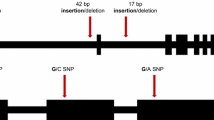Summary
We have used denaturing gradient gel electrophoresis (DGGE) to identify genomic DNA polymorphism in maize (Zea mays L.). DGGE probes detect polymorphism in maize at a frequency comparable to the incidence of restriction fragment length polymorphism (RFLP). Probes identifying polymorphism were mapped to maize chromosome arms by utilizing DGGE and maize lines carrying B-A chromosomal translocations. The methods for library construction, probe screening, and genome analysis, described here for maize, can also be applied to the genomic analysis of other organisms.
Similar content being viewed by others
References
Apuya NR, Frazier BL, Keim P, Roth EJ, Lark KG (1988) Restriction fragment length polymorphisms as genetic markers in soybean, Glycine max (L.) merrill. Theor Appl Genet 75:889–901
Beckett JB (1978) B-A translocations in maize. I. Use in locating genes by chromosome arms. J Hered 69:27–36
Beckmann JS, Soller M (1986) Restriction fragment length polymorphisms and genetic improvement of agricultural species. Euphytica 35:111–124
Burr B, Burr FA, Thompson KH, Albertson MH, Stuber CS (1988) Gene mapping with recombinant inbreds in maize. Genetics 118:519–526
Chang C, Bowman JL, DeJohn AW, Lander ES, Meyerowitz EM (1988) Restriction fragment length polymorphism map for Arabidopsis thaliana. Proc Natl Acad Sci USA 85:6856–6860
Darrah LL, Zuber MS (1986) 1985 United States farm maize germ plasm base and commercial breeding strategies. Crop Sci 26:1109–1113
DeBonville D, Riedel GE (1986) A robotic work station for the isolation of recombinant DNA. In: Hawk GL, Strimaitis J (eds) Advances in laboratory automation/robotics, Zymark Corporation, Hopkinton, pp 205–211
Donis-Keller H, Green P, Helms C, Cartinhour S, Weiffenbach B, Stephens K, Keith TP, Bowden DW, Smith DR, Lander ES, Botstein D, Akots G, Rediker KS, Gravius T, Brown VA, Rising MB, Parker C, Powers JA, Watt DE, Kauffman ER, Bricker A, Phipps P, Muller-Kahle H, Fulton TR, Ng S, Schum JW, Braman JC, Knowlton RG, Barker DF, Crooks SM, Lincoln SE, Daly MJ, Abrahamson J (1987) A genetic linkage map of the human genome. Cell 51:319–337
Feinberg AP, Vogelstein B (1983) A technique for radio labeling DNA restriction endonuclease fragments to high specific activity. Anal Biochem 132:6–13
Fischer SG, Lerman LS (1979) Length-independent separation of DNA restriction fragments in two-dimensional gel electrophoresis. Cell 16:191–200
Fischer SG, Lerman LS (1983) DNA fragments differing by single base-pair substitutions are separated in denaturing gradient gels: correspondence with melting theory. Proc Natl Acad Sci USA 80:1579–1583
Hake S, Walbot V (1980) The genome of Zea mays, its organization and homology to related grasses. Chromosoma 79:251–270
Helentjaris T (1987) A genetic linkage map for maize based on RFLPs. Trends Genet 3:217–221
Helentjaris T, Weber DF, Wright S (1986) Use of monosomics to map-cloned DNA fragments in maize. Proc Natl Acad Sci USA 83:6035–6039
Landry BS, Michelmore RW (1985) Selection of probes for restriction fragment length analysis from plant genomic clones. Plant Mol Biol Rep 3:174–179
Landry BS, Kesseli RV, Farrara B, Michelmore RW (1987) A genetic map of lettuce (Latuca sativa L.) with restriction fragment length polymorphism, isozyme disease resistance, and morphological markers. Genetic 116:331–337
Lerman LS (1986) Electrophoresis of DNA in denaturing gradient gels. In: Setlow JK, Hollaender A (eds) Genetic engineering, vol 8. Plenum, New York, pp 221–240
Lerman LS, Fischer SG, Hurler I, Silverstein K, Lumelsky N (1984) Sequence-determined DNA separations. Annu Rev Biophys Bioeng 13:399–423
Lerman LS, Silverstein K, Gringfeld E (1986) Searching for gene defects by denaturing gradient gel electrophoresis. Cold Spring Harbor Symp Quant Biol 51:285–297
Maniatis T, Fritsch EF, Sambrook J (1982) Molecular cloning: a laboratory manual. Cold Spring Harbor Laboratory Press, Cold Spring Harbor/NY
Myers RM, Lumelsky N, Lerman LS, Maniatis T (1985) Detection of single base substitutions in total genomic DNA. Nature 313:495–498
Myers RM, Maniatis T, Lerman LS (1987) Detection and localization of single base changes by denaturing gradient gel electrophoresis. Meth Enzymol 155:501–527
Noll WW, Collins M (1987) Detection of human DNA polymorphisms with a simplified denaturing gradient gel electrophoresis technique. Proc Natl Acad Sci USA 84:3339–3343
Paterson AH, Lander ES, Hewitt JD, Peterson S, Lincoln SE, Tanksley SD (1988) Resolution of quantitative traits into Mendelian factors by using a complete linkage map of restriction fragment length polymorphisms. Nature 335:721–726
Roman H (1947) Mitotic nondisjunction in the case of interchanges involving the B-type chromosome in maize. Genetics 32:391–409
Roman H, Ullstrup AJ (1951) The use of A-B translocations to locate genes in maize. Agron J 43:450–454
Sheffield VC, Cox DR, Lerman LS, Myers RM (1989) Attachment of a 40-base-pair G+C-rich sequence (GC-clamp) to genomic DNA fragments by the polymerase chain reaction results in improved detection of single-base changes. Proc Natl Acad Sci USA 86:232–236
Sheldon EL (1982) The construction of maize DNA libraries. In: Sheridan WF (ed) Maize for biological research. University Press, Grand Forks/ND, pp 197–202
Shure M, Wessler SR, Federoff NV (1983) Molecular identification and isolation of the waxy locus in maize. Cell 35:225–233
Tanksley SD, Mutschler MA, Rick CM (1987) Linkage map of the tomato (Lycopersicon esculentum) (2n=24). In: O'Brien SJ (ed) Genetic maps 1987. A compilation of linkage and restriction maps of genetically studied organisms. Cold Spring Harbor Laboratory Press, Cold Spring Harbor/NY, pp 655–669
Walton MF, Helentjaris TH (1986) Informativeness of restriction fragment polymorphism (RFLP) markers in maize. In: Agronomy Abstracts. American Society of Agronomy, Madison/WI, p 152
White R, Leppert M, Bishop JM (1985) Construction of linkage maps with DNA markers for human chromosomes. Nature 313:101–105
Wyman AR, White R (1980) A highly polymorphic locus in human DNA. Proc Natl Acad Sci USA 77:6754–6758
Author information
Authors and Affiliations
Additional information
Communicated by J. Beckmann
Rights and permissions
About this article
Cite this article
Riedel, G.E., Swanberg, S.L., Kuranda, K.D. et al. Denaturing gradient gel electrophoresis identifies genomic DNA polymorphism with high frequency in maize. Theoret. Appl. Genetics 80, 1–10 (1990). https://doi.org/10.1007/BF00224008
Received:
Accepted:
Issue Date:
DOI: https://doi.org/10.1007/BF00224008




